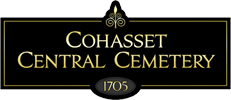EMBRACING OUR HERITAGE
A self-guided historical tour of Cohasset Central Cemetery, its intriguing residents and their monuments.
Welcome
In the 1700s, Cohasset was growing in industry, strength and numbers. As the Second Precinct of Hingham, Cohasset had a town common and a meetinghouse. Farming, shipbuilding, milling, and other industries increased its financial stability. Cohasset separated from the Town of Hingham in 1770 forging a new course, with independent civic responsibilities.
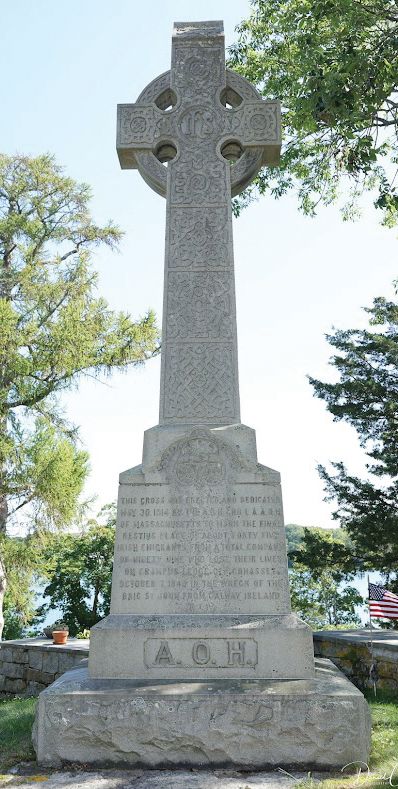
Overlooking Little Harbor, a stone’s throw from the town common is the Cohasset Central Cemetery, a place of great beauty and peace. Since Margaret Tower’s burial in 1705, the cemetery has been active for over three centuries. Now it has close to 600 grave sites along with four columbaria. Its many markers of slate, marble, and granite are witness to the passage of time, changing fortunes, beliefs, customs and styles.
The oldest parts of the cemetery are known as the “Old Slates,” containing the graves of Cohasset’s earliest settlers and families. They were farmers, fishermen, shipbuilders, and seafarers including Towers, Pratts, Lincolns, Bates, Beals, and Hobarts, among others.
In 1867, the Town of Cohasset turned the “Burying Grounds” over to a private, not-for-profit association of townspeople, forming the Cohasset Central Cemetery. That same year, Edward Everett Tower conveyed a parcel of land north of the original burying ground, bringing the acreage of the cemetery up to the road line of North Main Street.
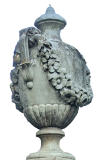
Cohasset resident Charles S. Bates donated the northwest portion of land in 1873. The addition of this acreage brought the cemetery to its present 4.3 acres. Bates also donated funds to construct the brick receiving tomb, now used as the caretaker’s shed.
The Cemetery’s Board of Directors is responsible for maintaining and preserving the character, physical, and fiscal integrity of this rustic, colonial cemetery.

Visitor information
parking
Please respect our neighbors.
Parking is allowed along Joy Place or Terrace and Seaside Avenues within the cemetery.
ADDRESS & HOURS
Joy Place, Cohasset, MA 02025
7 a.m. to Sundown
Aerial Map
QUESTIONS? CONTACT US.
historical features
Cohasset Central Cemetery is located adjacent to Little Harbor, a section of pastureland created by construction of the 1765 Cuba Dam that flooded in the storm of 1851, transforming the area into the current large sandy-bottomed area.

In 1873 a brick receiving shed that held up to six caskets was built. This building is now the caretaker’s building.

The main gate and several family plots show beautiful examples of cast iron fencing, often with a twig and branch style. Ongoing restoration projects include the family plots of Paul Pratt, George Hall, Ezekiel Pratt, Daniel Lothrop, Elijah Lincoln, and Ezekiel Wallis.
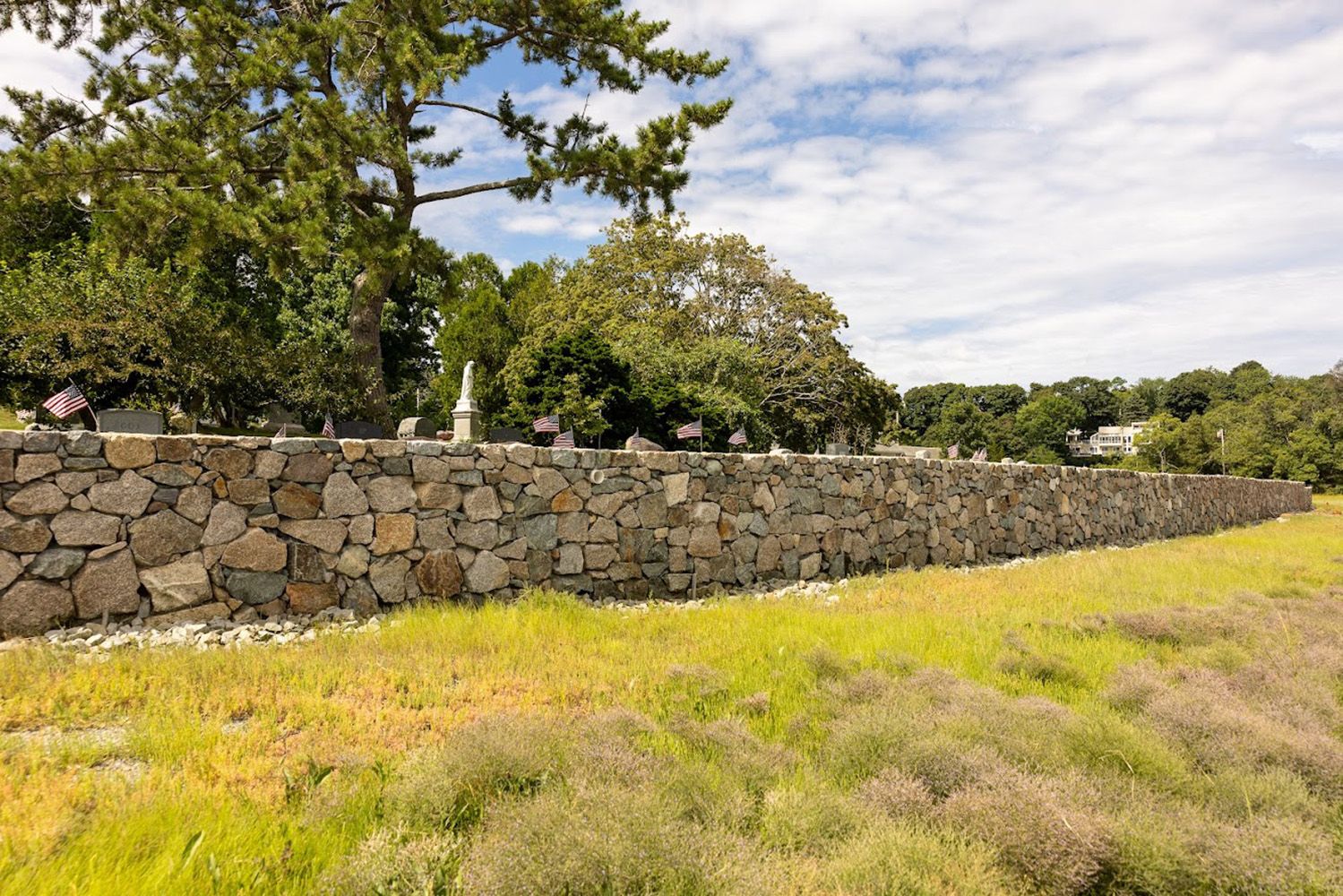
The 500-foot seawall bordering Seaside Avenue was constructed in 2019.
This project was completed in conjunction with raising the lower part of the cemetery to mitigate the impact of future sea level rise and subsequent flooding.
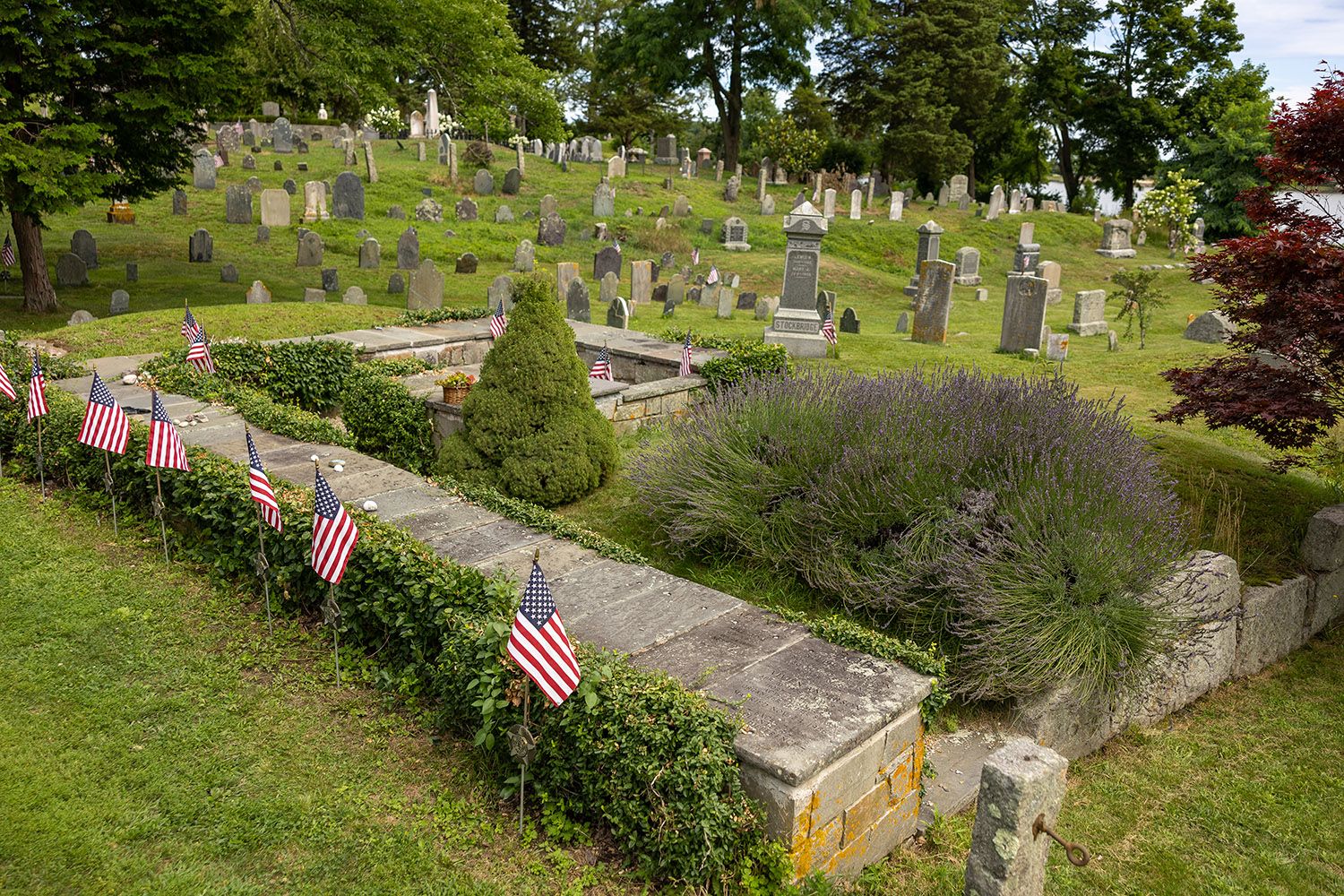
The columbaria on the property honor several former officers of the Cemetery Board of Directors: Prescott T. Cumner built in 1982, Edward E. Tower - 1988, Daniel C. Cotton - 2007, Philip L. Towle - 2023.
They are walled with granite and fit into the contours of Joy Place.
take the Tour
Plaque Detail
- Plaques 1-32
- David Bates
- Levi Willcutt
- John Jacob
- Ignatius Orcutt
- Rev. Nehemiah Hobart
- Deacon Abel Kent
- Rev. John Browne
- Abel Kent
- Bethiah "Resolution" Nichols Tower
- Abraham Tower
- Abraham Hobart Tower
- Isaac Lincoln
- Paul Pratt
- Margaret Tower, Ibrook Tower
- Daniel Tower
- Gilbert S. Tower
- Thomas Stevenson
- John Stephenson
- Capt. James Hall, Persis Tower Hall
- Elijah Lincoln
- Sarah Pratt
- Cousens Family
- Capt. George Hall
- Ezekiel Stetson, John Stetson, Lydia Stutson
- Urian Oakes
- James Stoddard
- Aaron Pratt
- Christopher James
- Phineas/Aaron Pratt Family Monument
- William Hanlon
- Thomas W. Clarke
- James W. Nichols
- Plaques 33-39
- Plaques 40-54
- Charles B. Nichols
- Helen Howes Vosoff
- Levi B. Gaylord
- Edward Tower
- Francis W. Hagerty, Mary F. Hagerty
- Howard S. Reid, MD
- Richardson White
- Vietnam Casualties
- Marion H. Gibson Woods
- Jessie Bancroft Cox, William C. Cox, Jane Steele Cook
- Lawrence P. Barrett
- Stuart Robson
- George H. Mealy
- Samuel L. Jenkins
- Joseph H. Smith
- Plaques 55-64
- Artistic Features
GRAVE MEDALLIONS
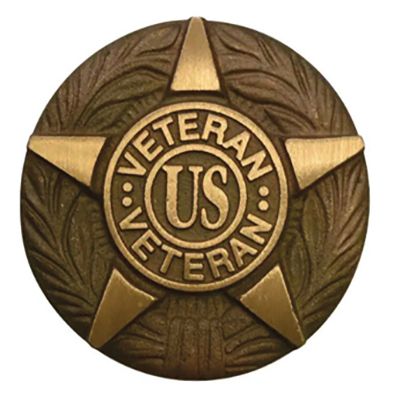
U.S. VETERAN
Flag holder medallion for all who have served in the U.S. Armed Forces.
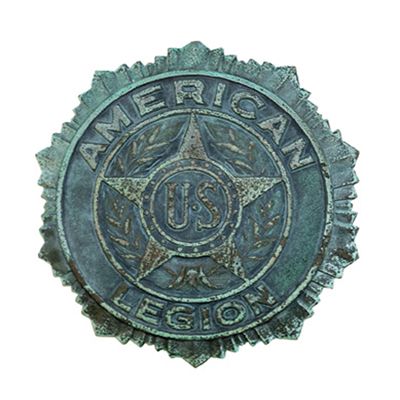
AMERICAN LEGION
U.S. war veterans.
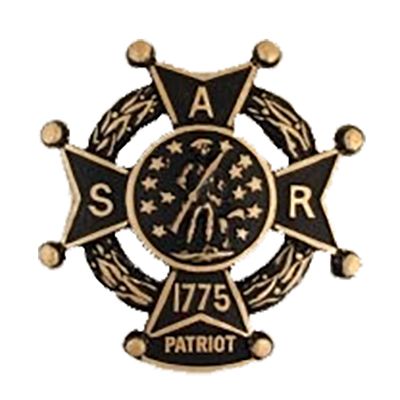
SAR 1775
Sons of the American Revolution, for those who fought in the Revolutionary War.

BOSTON TEA PARTY PARTICIPANT
At the graves of Abraham Tower and James Stoddard.

FLT IOOF
Independent Order of Odd Fellows is a fraternal organization founded in 1806. Their motto: Friendship, Love, Truth.

GAR
Grand Army of the Republic is a fraternal organization of the Union Army, Navy, and Marine Civil War veterans.

COHASSET FIREMEN’S RELIEF ASSOCIATION
Organization provides death, disability and retirement benefits for its members.

GOLD STAR MOTHER
Mothers of U.S. Armed Force members who died either on active duty, as a result of service, or were MIA.
ARTISTIC ERAS OF GRAVESTONES
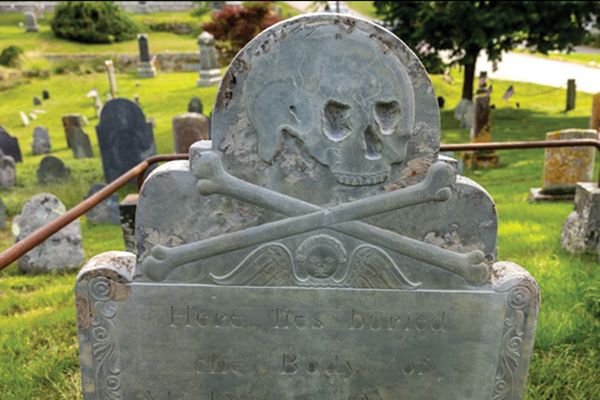
Nearly 600 gravestones span three centuries, from the earliest markers to the current columbaria. In the cemetery’s original burying ground are the “old slates”, beginning with the 1706 headstone of Sarah Pratt.
Nearby quarries provided the slate for these early stones. The slates were laid out in small rows, facing west towards the setting sun.
Typically, the carvings across the top of the stones featured items such as skulls with crossbones or wings, such as Urian Oakes, reflecting Puritan awareness of mortality and belief in resurrection.

Over the years the skulls gave way to winged cherubs and later willows and urns. There are many good examples of local carvers who used favorite details as their trademark like the heartmouth carvings on the Stetson siblings. The expansion of the property to the south brought new styles and materials. By the early 1800’s, Vermont quarries made white marble available and affordable, as seen in the gothic arched style stones, carved hands and figures.
Since the soft stone was easy to carve, a variety of statuary, urns and obelisks rest on the gravesites of this period. These memorials reflect the sentimental Victorian era.
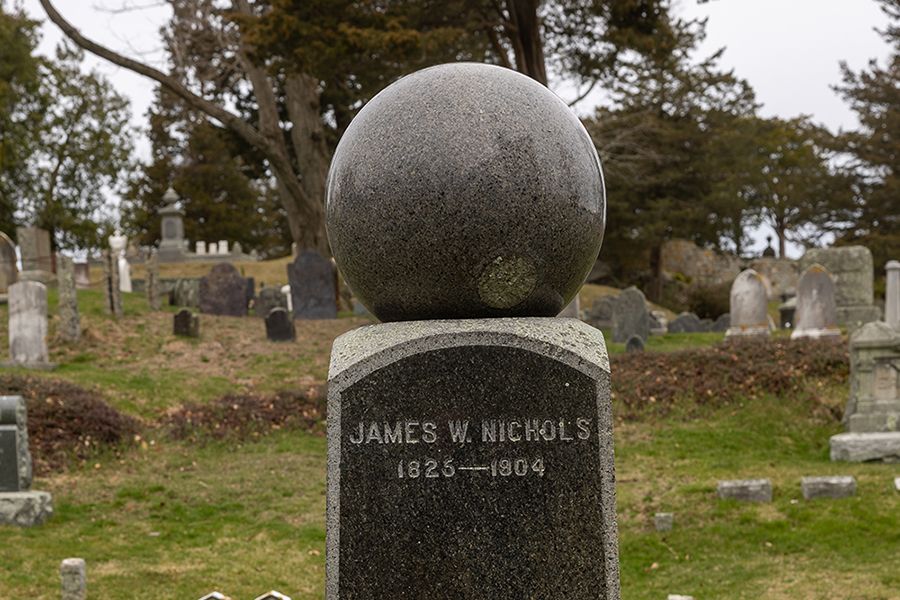
Later the Quincy quarries yielded a dark gray granite which became the stone of choice, although marble was still used often combined with granite. The stones were no longer arranged in rows, and the artwork reflected a more poignant attitude towards death. In the late 19th and 20th century, the stones spreading north were granite and marble, many which were carved with classical architectural elements.
Later styles include unfinished stones and simple flat markers. Two large granite balls placed on their monuments demonstrate a scientific phenomenon. The heavy balls rotate slightly over time due to gravity, temperatures, and weather.

A heartfelt thank you
We couldn't have created this tour without the help and commitment of these people.
- President Rick Towle of Cohasset Central Cemetery
-
Cohasset Central Cemetery Historical Committee: Susan Spofford, Maryanne Wetherald, Shelanne Durkin, Julia Gleason, Suzy Wadsworth
- Cohasset Central Cemetery: James "Benji" Watson, landscaping services
- Dan Leahy Photography
- Kerry Cassone and team of Zacaw Enterprises Inc., Web Design
- Abby Scholz, Graphic Designer
- Curator Lynne DeGiacomo and colleagues of Cohasset Historical Society
- Steve Stankiewicz, Map Illustrator
- David Hassan of Hassan Wood Carving & Sign
- Renee Melbourn of Nameplate & Panel Technology
- Author Jacqueline M. Dormitzer of "Narrative History of Cohasset," Volumes 1, 2, 3
- Philip Mahoney, Veteran’s Agent, Veteran Services
